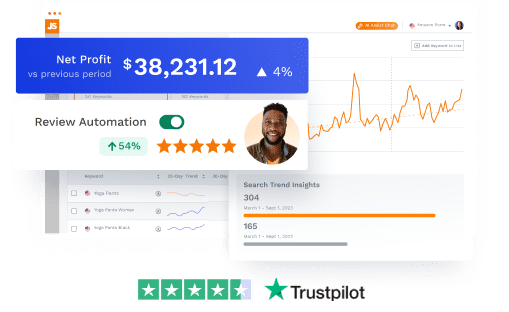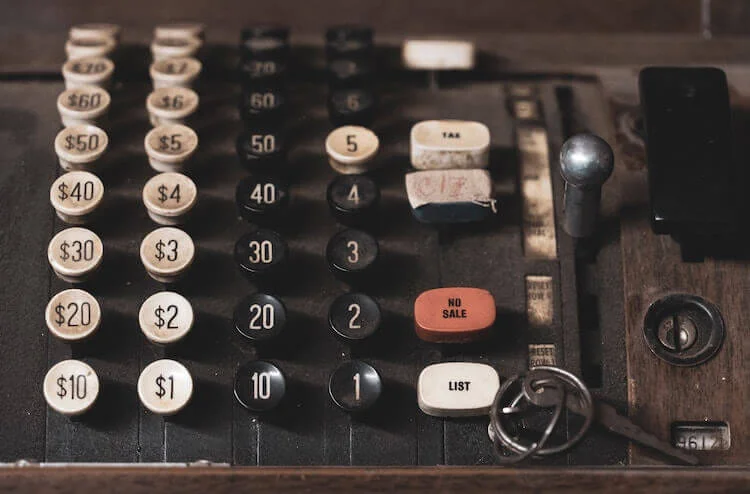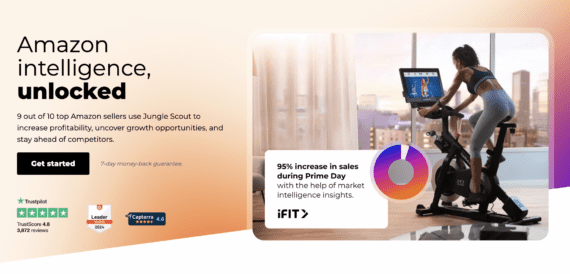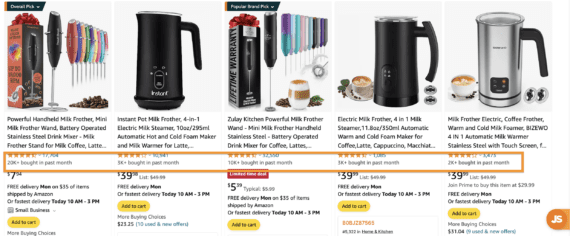Table of Contents
What is the 2.5 Rule?
How is the 2.5 Rule calculated?
How can I predict Amazon PPC Costs in advance?
How do I build a keyword list using the 2.5 Rule?
How do I know if a product is too competitive using the 2.5 Rule?
Can I raise my product’s price to meet the 2.5 Rule?
More things to consider when estimating Amazon PPC costs
Do you follow the 2.5 Rule?
Content
expand_moreTable of Contents
What is the 2.5 Rule?
How is the 2.5 Rule calculated?
How can I predict Amazon PPC Costs in advance?
How do I build a keyword list using the 2.5 Rule?
How do I know if a product is too competitive using the 2.5 Rule?
Can I raise my product’s price to meet the 2.5 Rule?
More things to consider when estimating Amazon PPC costs
Do you follow the 2.5 Rule?
Not knowing your numbers is a big mistake many new Amazon sellers make. If you don’t understand all of the costs involved with selling on Amazon, you won’t know if you’re actually making a profit.
With tools like Jungle Scout, sellers can accurately predict their profit margin before investing in inventory by calculating the cost of goods, Amazon FBA fees, and selling price. However, a cost that is often overlooked is the cost of Amazon PPC advertising.
In this article, we’ll teach you how to estimate your Amazon PPC costs using a simple trick called the 2.5 rule, along with a tool within Jungle Scout. Knowing this rule will help you more accurately predict your potential PPC costs, preventing you from overspending on your ad campaigns.
What is the 2.5 Rule?
The 2.5 Rule is a method of predicting Amazon PPC costs using a little math and a cool tool we call Keyword Scout. First, understand that it operates on a few assumptions:
- The product has the typical Amazon conversion rate of 10%. That means for every 10 people who click on your product, 1 of those people makes a purchase.
- Your target ACoS is 25% of your sales price.
Now that you understand these assumptions, let’s go over how the 2.5 Rule works.
How the 2.5 Rule works
When researching keywords for your Amazon PPC ads, each keyword should cost no more than 2.5% of the product’s sales price.
For example, say you’re selling a long-handle garlic press for $27.95. You discover that the Amazon PPC costs to get your product to the first page of search results for the keyword “long-handle garlic press” is $0.56 per click. $0.56 per click is less than 2.5% of your sales price. Therefore, that is a good keyword to target.
Another example: you’re still selling the long-handle garlic press for $27.95. This time, you want to go for the broader keyword “garlic press” minus the “long-handle.” It’s a more competitive keyword, costing $1.23 per click. That’s 4.4% of your sales price. So, that might not be the best keyword to target, especially if you want to get a healthy profit margin.
How is the 2.5 Rule calculated?
The math is quite simple. If you are selling a product on Amazon that has a 10% conversion rate, that means it takes, on average, 10 clicks to make a sale. If your target ACoS (advertising cost of sales) is 25% of the total sales price, then your average Amazon PPC costs need to be 2.5% of the total sales price. Here’s the long version for the formula for calculating it.
The Long Version
PRICE x 25% = Target ACoS
Target ACoS ÷ 10 Clicks = 2.5%
Amazon PPC Costs = 2.5% of Total Sales Price
But all you need to do is this:
The Short Version:
PRICE x 2.5% = Your Target Amazon PPC Costs
In other words, simply multiply your product’s sales price by 0.025 and you will find your target Amazon PPC Costs.
How can I predict Amazon PPC Costs in advance?
The easiest way to predict Amazon PPC Costs is through Jungle Scout’s Keyword Scout tool. Keyword Scout actually gives you real live Amazon PPC Costs taken directly from Amazon.

Keyword Scout will show you the estimated PPC bids for broad and exact match keywords. When doing product research, knowing the estimated bid cost is great information to have so you can find out your target Amazon PPC costs.
How do I build a keyword list using the 2.5 Rule?
Now that you’ve used Keyword Scout to perform Amazon PPC Costs research, you’ll want to select the keywords that will not only get your product seen by more shoppers, but also keep your ACoS below 25%, or, less than 2.5% per click.
One easy way to build this list is by sorting the list of keywords provided by Keyword Scout in ascending order of Exact PPC costs. Use Exact because it shows the cost of that exact keyword phrase. Broad match keywords will show up for different search variations, and the cost may also vary.
From there, simply export the keyword list and remove any that do not meet the 2.5 Rule.
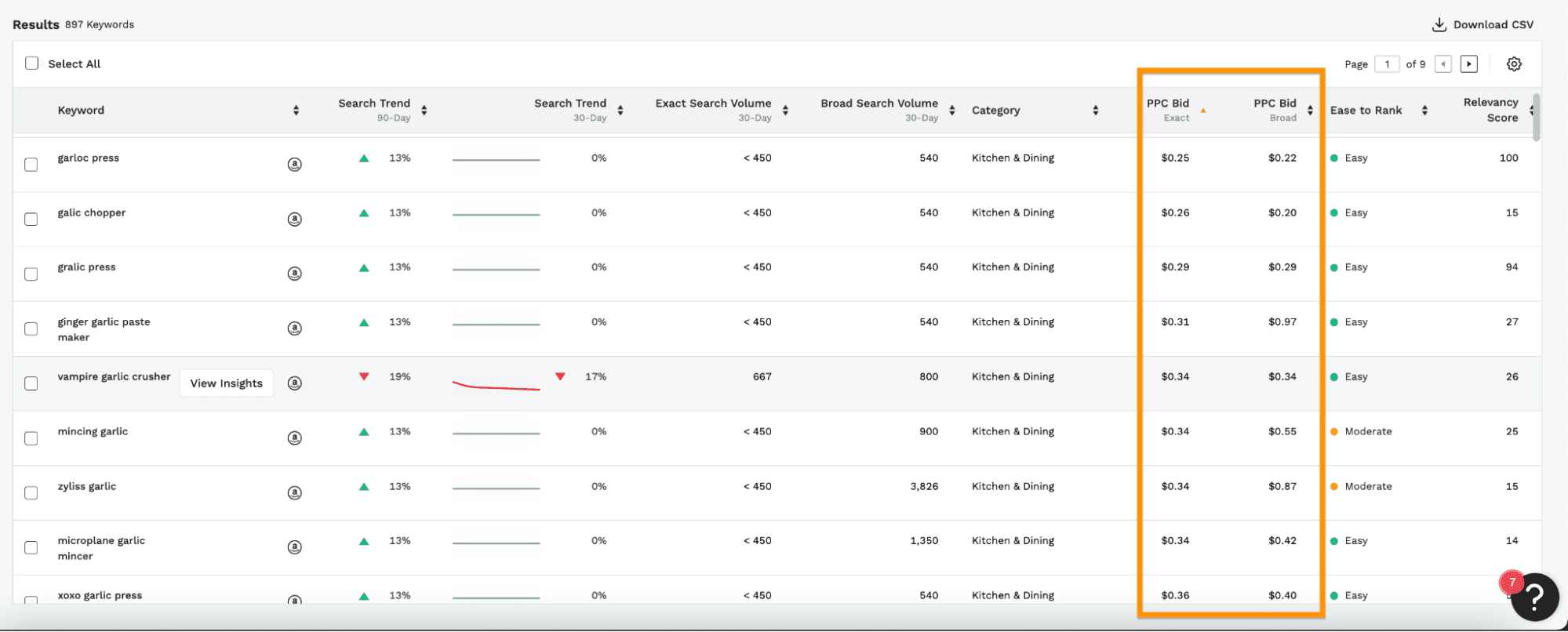
However, keep in mind if you see a keyword that is very relevant with a high search volume (1,000 searches and up) and doesn’t meet the 2.5 Rule, doesn’t mean you should automatically exclude it from your PPC campaigns. Just be aware it will likely cost more per click to get the top ad position in the search results.
How do I know if a product is too competitive using the 2.5 Rule?
Another benefit of using Keyword Scout and the 2.5 Rule is knowing whether or not a product is too competitive. You may have noticed from our list of keywords under 2.5% of our target sales price, those keywords have relatively low search volumes. This is probably a signal that garlic presses are far too competitive on Amazon. Extension confirms this, giving it an Opportunity Score of 3 “High Demand with High Competition.”
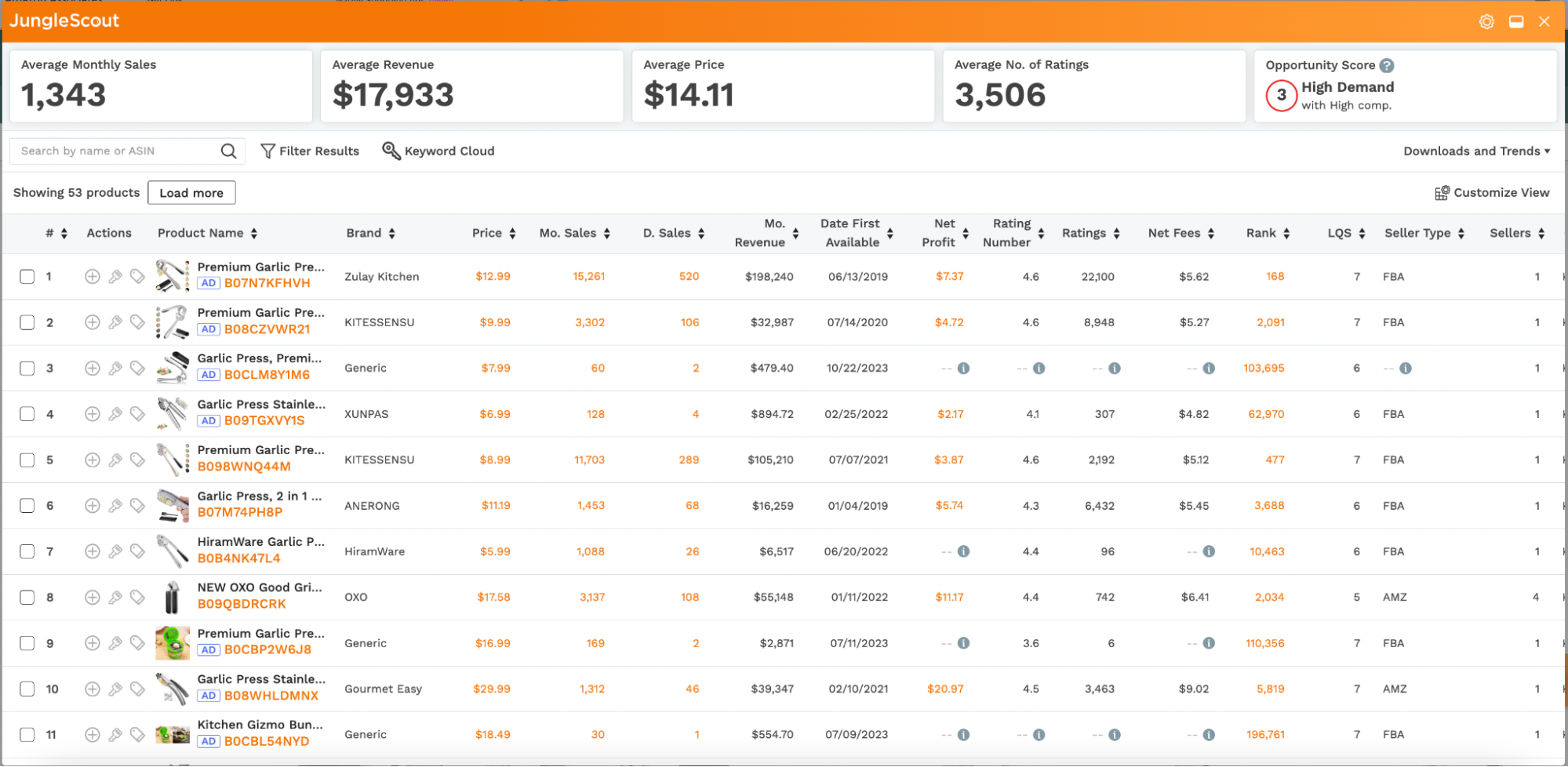
As a rule of thumb, you might try to get the sum of the search volume for each of your 2.5 Rule keywords to be 3,000+ monthly searches. Any less than that, and you might find it difficult to move inventory. Furthermore, try not to leverage the monthly searches on only one keyword, especially if it’s something obvious or short tail.
Can I raise my product’s price to meet the 2.5 Rule?
Obviously, raising your product’s price beyond your initial target sales price will make your margin for Amazon PPC Costs much wider. For example, if I raised my garlic press’ price by $10 to $37.95, that would make my target Amazon PPC Costs $0.95 per click. That’s a much easier margin to work with!
However, raising your price too high above your competitors’ prices might lower your conversion rate significantly. So, instead of selling a product every 10 clicks, it may take 15 to 20 clicks to sell your product. At that point, the 2.5 Rule doesn’t work as well.
I recommend keeping your sales price no more than 30% higher or lower than the average sales price. So, if garlic presses are selling for $25 on average on Amazon, your price should be somewhere between $17.50 and $32.50.
More things to consider when estimating Amazon PPC costs
Of course, the 2.5 Rule is a good basic rule of thumb and may not be a silver bullet for every seller. Here’s a few more things to consider when estimating your Amazon PPC costs:
Higher prices equals lower conversion rates.
Try to learn what your average conversion rate will be before pricing out your Amazon PPC ads. The lower your conversion rate, the more clicks it takes. Here’s a quick cheat sheet for conversion rates and clicks.
- 20% conversion rate = 1 sale per 5 clicks
- 15% conversion rate = 1 sale per 7 clicks
- 10% conversion rate = 1 sale per 10 clicks
- 5% conversion rate = 1 sale per 20 clicks
- 2% conversion rate = 1 sale per 50 clicks
Your target ACoS doesn’t have to be 25%.
Once you subtract your Amazon fees and costs of goods sold, you might have a larger gross margin to work with than others. In this case, you can always raise your target ACoS above 25%. Just remember that the bigger your ACoS is, the less profit you’ll make. So if you have a gross margin of 50% after fees and product costs and decide to target a 40% ACoS, that only leaves 10% for your profit margin!
Generate Amazon Keyword Reports.
Amazon keyword reports will help you get even more accurate details on costs per click and conversion rates. You should run these reports at least once a week for a few months after launching a product. You can find your keyword reports in Amazon Seller Central > Reports > Advertising Reports.
ABR – Always Be Researching.
Use Keyword Scout frequently to find new keywords. Remember, Keyword Scout generates a list of keywords based on keywords and ASINs that you enter in the search box. Eventually, your keyword reports will direct you to your highest converting keywords. So, take those words and put them into Keyword Scout again. Bam! A whole new set of ultra-relevant keywords emerge, ready for you to put them into your Amazon PPC campaigns. Keep this up for a year and you’ll find yourself with a massive list of high-converting, long-tail keywords.
The seller who continues to do Amazon keyword research and track their Amazon PPC costs is the seller who ends up dominating their category and earning the highest profits.
NOTE: Once your product is live, you can track your PPC spend using
Jungle Scout’s Sales Analytics feature.
Do you follow the 2.5 Rule?
We hope this article gave you a better understanding of estimating your Amazon PPC costs using the 2.5 Rule. Of course, it doesn’t need to be followed to a T, but it is a good way to estimate your overall profits when choosing a product to sell on Amazon.
Learn more about Jungle Scout
Are you ready to begin selling on Amazon? Get everything you need, including Keyword Scout and the Jungle Scout Extension, here!
Brian Connolly is an Amazon seller, ecommerce expert, and writer for Jungle Scout. He lives in the New Jersey Shore area with his wife and cat. When he isn’t writing advice online for aspiring and experienced Amazon sellers for Jungle Scout, he spends his free time boating, fishing, and selling boating-themed items on his Amazon business.


